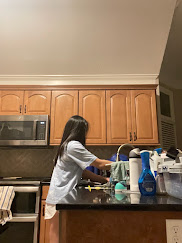Posture and Body Mechanics
With their permission, I have attached three photos of my good friends; Tess, Sarah, and Alyssa. In picture one, Tess is sitting down organizing her closet. In picture two, Sarah is sitting down, drinking slush on her phone. In picture three, Alyssa is washing dishes.
In picture three, Alyssa is washing dishes. She is standing on both feet with a slight anterior pelvis tilt caused by the shortening of her hip flexors and lengthening of hamstrings while leaning onto the counter. Her femur is in anatomical position because she is standing. She has increased thoracic kyphosis and cervical flexion from looking down at the dishes she is washing. Her shoulders are in flexion and her elbows are in extension. Her scapulae is in protraction. Her feet are shoulder width apart which gives her a relative small base of support. This position allows stability for her lower extremity and allows mobility for her upper extremity to wash the dishes. Her spine is not in alignment with the lower half of the back and due to her back and hips being slightly flexed. In this position, I would imagine her knee and ankle joints are taking on the weight bearing duties. She is leaning on the counter which could help alleviate pressure on her knees.
I would educate my clients that having good posture and body mechanics reduces injury and allows all internal organs and muscles to function properly. I would educate my client that bad posture can lead to deformities over time and that ninety percent of lower back pain comes from poor posture. I would tell my client to use a step tool and alternate between her left and right foot to alleviate the pressure.
References
Weisser-Pike, O. (2023). Lecture 8 Vertebral Column, Posture, and Body Mechanics [PowerPoint presentation].
Pictures Retrieved from: Personal Cell Phone




Comments
Post a Comment